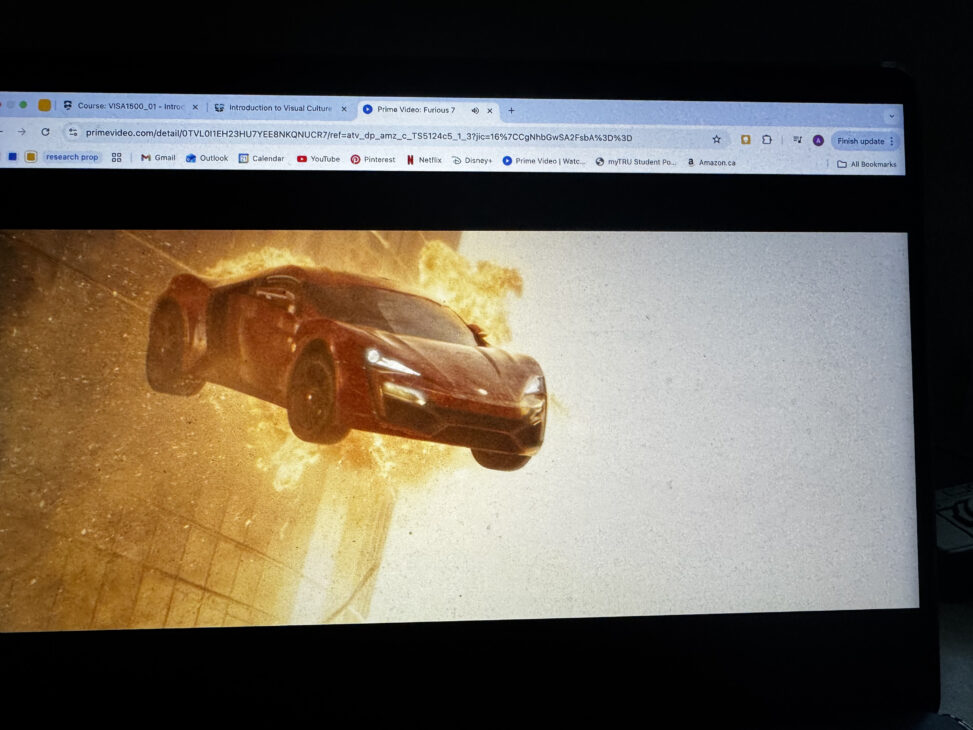The most recent action film I’ve watched is Fast and Furious 7 and decided to focus on one specific scene which is the Abu Dhabi skyscraper car jump. As shown on the screen grab we can see a Lykan Hyper Sport (a very rare vehicle) use as the main piece of the whole scene and stunt, jumping from one building to the other while an explosion is happening from behind. Inside the car is Dominic Toretto and Brian O’Connor, two of the main characters of the movie. In this scene we can see the emphasis on luxury, height and danger all combine.
The mise en scène of the scene emphasizes various elements to vividly capture the setting, which features a luxurious skyscraper with reflective windows and a penthouse storing a car. When the car leaps, it reveals the expansive city and ocean of Abu Dhabi. The lighting is highlighted by an intense orange and yellow hue from sparks and fire, harmonizing with the bright sunlight that creates a white sky, enhancing the car’s height during its jump and making the stunt appear larger than life. This glowing effect adds drama and maintains the car as the focal point. The tone is intense and explosive, evoking a life-or-death feeling and maximizing suspense, driving adrenaline through viewers. The car is positioned slightly left in the frame, angled downwards while mid-air, suggesting its high-speed escape from the skyscraper amidst dust, glass, and flames. Dominant colors include bright orange and glowing gold, signifying heat, danger, and explosive action, while the car’s red color symbolizes danger, speed, and power, ensuring it stands out against the fiery background. Contemporary action cinema emphasizes spectacle as a defining aesthetic: large, visually arresting set pieces (explosions, high-speed chases, gravity-defying stunts) are edited in a hyperkinetic style (very short shot lengths, rapid cutting, frequent POV switches, and slow-motion inserts) that prioritizes sensory intensity over transparent continuity. This “fast cinema” or spectacle paradigm stylizes danger and builds situations as spectacular happenings to be gazed at rather than seen in real time(Cieślak, F. 2021)
This scene is connected between a fight they are trying to escape which are a fast-paced shots film before that specific scene, this shows urgency and a fast environment. During the scene the music is turn-off and is slower than normal scene to build that suspense of the stunt that is happening. After, the pace speeds up again with wide shots, reaction shots and exterior views of the car flying between buildings.
The movie has many intense scenes that involve violence and action, but the chosen scene involves high- intensity action but avoids graphic detail. The violence is stylized, quick, and more about the spectacle rather than the harm. It focuses on the motion (the car crashing through the glass, the height, the speed) rather on people being injured. It shows how the main characters can work under pressure and get the mission accomplished.
The main actors in the car (Dom and Brian) are male heroes. They are leaders of their group and show their confidence and physical capability. For Dom he represents the Latino heritage, representing a multicultural cast and the film also portrays him as equals with Brian in skill and importance. When competence, agency, and survivability are unevenly distributed across gender/racial lines on-screen, the genre’s spectacle reinforces social narratives about who is “allowed” to perform risk or be heroic(Gürkan, Hüseyin, and Ahmet Serttaş. 2017). Their ability is portrayed as skilled drivers, calm under pressured, and physically strong. Their abilities are a little far from reality but still grounded enough to feel like an action movie realism. The main representation reinforces themes of teamwork and shared values.
The ecology of the scene are the skyscrapers, glass walls, narrow spaces and height that become obstacles and tools which shapes the action that is the reason they jump between towers is that there is no other escape route. All the polished surfaces and glass create a visual clarity but also fragility which leads to the action depending on the setting.
In the sequence from 1:17:52 to 1:18:52 there were around 65 edits per minute, showing that many shots are one or only two seconds long. When editing like this it creates more excitement and makes the scene more chaotic. This has become a prevalent pattern in action films making a spectacle plus fast editing have become a normative aesthetic strategy, used to maximize arousal and global market appeal(Cieślak, F. 2021). During this minute the point of view changes a lot, we can see inside the car which are close-ups on Dom and Brian, exterior shots showing the buildings and the stunts, camera behind the car, and a POV seeing what Dom and Brian see. Because of everything happening so fast the camera movements is highly dynamic and noticeable. It is design to make the viewer feel speed and danger. The camera does a tracking and following movement (moves with the car), push-ins (moves closer to the characters), sweeping and arcing movements (the camera swings when the car leaves the building), shaky movements inside the car (suggesting the impact the characters feel), and slow-motion emphasis (the camera appears to “float”). the editing in this sequence is obvious instead of seamless. It uses quick cuts, changing point of view, slow motion, and reaction shots to make things more exciting and tense instead of making them look natural. You can notice that you are seeing distinct shots that have been put together instead of one long moment.
According to Box Office Mojo Furious 7 had a domestic release of $353,007,020, international release of $1,162,334,379 and worldwide of $1,515,342,457 making it a very successful film. It reached a US$1 billion worldwide in only 17 days. Compared to its budget, the film made several times more marking it a major financial success
Action films don’t cause behavior, but they can influence attitudes about dangers, risk, gender roles, power, and control. Studies show that watching violent movie content also weakens and decreases adolescents’ behavioral inhibition power(Ghandali, R., et al, 2022) When being exposed to violent or high-risk screen material increases in short-term hazardous decision-making or reduced behavioral inhibition in teenagers. Because of the mainstream action films repeatedly present risky stunts, survivable scenarios and much more they can normalize the image of risk for viewers. High impulsivity and Sensation Seeking can increase risk for problem behaviors through greater exposure to risky media, and by operating as moderators, although the influence of SS on some forms of risk-taking (e.g., experimentation with alcohol use) seemed to be stronger for White youth than Black youth (Khurana, A. et al, 2019)
In conclusion, the automobile jump from the Abu Dhabi building in Fast and Furious 7 is a good example of how modern action movies use spectacle, quick cuts, and dangerous stunts to build tension and excitement. Through mise-en-scène, lighting, and dynamic camera work, the scene emphasizes danger, speed, and heroism, while portraying male characters as competent, physically capable, and collaborative. Although stylized and exaggerated, such scenarios have the potential to affect teenage viewers’ perceptions of danger and behavioral decision-making, particularly those with strong impulsivity or sensation-seeking inclinations. Finally, the scene highlights how action films use narrative, visual, and technological components to entertain, support societal myths about heroism, and influence viewer participation with danger and spectacle.
References
1. Cieślak, F. 2021. “Spectacle in Contemporary Mainstream Action Cinema.” Panoptikum (26): 61–79. doi:10.26881/pan.2021.26.03.
2. Gürkan, Hüseyin, and Ahmet Serttaş. 2017. “The Representation of Masculinity in Cinema and on Television: An Analysis of Fictional Male Characters.” European Journal of Multidisciplinary Studies 5 (1): 402–408.
3. Ghandali, R., Hassani-Abharian, P., Sadeghi-Firoozabadi, V., and Nooripour, R. “The Effect of Violent and Melodrama Movies on Risky
4. Khurana, A., Bleakley, A., Ellithorpe, M. E., Hennessy, M., Jamieson, P. E., and Weitz, I. 2019. “Sensation Seeking and Impulsivity Can Increase Exposure to Risky Media and Moderate Its Effects on Adolescent Risk Behaviors.” Prevention Science 20 (5): 776–787. doi:10.1007/s11121-019-0984-z.


Provide Feedback